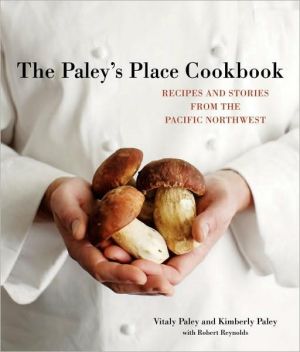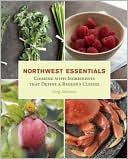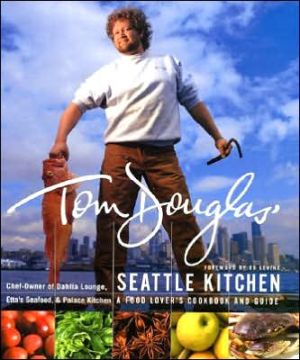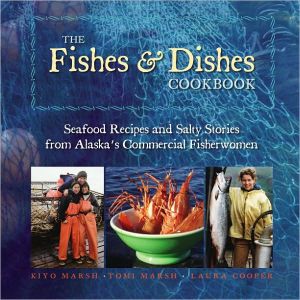Paley's Place Cookbook: Recipes and Stories from the Pacific Northwest
Nestled in a converted Victorian in Portland's trendy Northwest District, Paley's Place Bistro and Bar has been serving Vitaly Paley's creative, beautifully executed cooking for over a decade. Co-owner Kimberly Paley's joyous hospitality has helped make their restaurant into a West Coast destination. Both Paleys' unquenchable ardor for local, luscious, sustainably produced food and drink means the Paley's Place dining experience just keeps gets better. With characteristic generosity,...
Search in google:
Nestled in a converted Victorian in Portland's trendy Northwest District, Paley's Place Bistro and Bar has been serving Vitaly Paley's creative, beautifully executed cooking for over a decade. Co-owner Kimberly Paley's joyous hospitality has helped make their restaurant into a West Coast destination. Both Paleys' unquenchable ardor for local, luscious, sustainably produced food and drink means the Paley's Place dining experience just keeps gets better. With characteristic generosity, Vitaly and Kimberly bring their elegant, soulful fare home in The Paley's Place Cookbook. Chapters on appetizers; soups, salads, and sandwiches; pastas and grains; fish and shellfish; meat, game, and fowl; vegetable side dishes; and desserts are complemented by extras, including a primer on putting together a knockout Oregon cheese course and a bevy of recipes for hand-crafted and seasonal cocktails. Wine pairings point the reader to well-matched styles and makers from the Pacific Northwest and France. Teaching the reader to create blissfully perfectdishes from the ground up, whether simple (Grilled Figs Wrapped in Prosciutto; Tomato-Bread Soup) or showy (Duck Wellington with Mole Sauce; Vegetable-Stuffed Morels with Green Garlic Confit and Parmesan Cream), the authors emphasize the building blocks of wonderful food: great ingredients and great technique. Throughout the book, the Paleys introduce us to some of the many skilled food producers who make the Pacific Northwest a culinary treasure trove, and also take us inside the chef's thought process as he creates and refines his recipes. Evocative photographs—of finished dishes, gorgeous localfoodstuffs, and the people who produce the food that gives so much pleasure—round out this personal, passionate, enlightening, and utterly delicious cookbook. Publishers Weekly This scrumptious collection of recipes and stories from the owners of Paley's Place Bistro and Bar in Portland, Ore., offers an intriguing mélange of Eastern European Jewish, Mediterranean, mainstream American and Pacific Northwest culinary influences, from Truffled Crab Melt to Duck Wellington with Mole Sauce, designed to match a Syrah's flavors of cinnamon, clover, black pepper, cayenne, butter, chocolate, tobacco and fungus. Some recipes are almost outrageously simple, like George's Gathered Greens: mixed greens, lemon, olive oil, salt and pepper. But most are complex, and many, like Chicken Roulade, in which chicken legs are ground with herbs and wrapped with breasts in caulfat-the lacy "lining of a pig's abdominal cavity" that keeps the chicken "beautifully moist, then melts away in the cooking"-require elaborate preparation, which, fortunately, the authors illustrate with excellently detailed photos. The Paleys often highlight their suppliers, such as Gene Thiel, a potato farmer in his 70s, who "speaks of the pleasing esters present in potatoes, explaining how they affect both taste and smell" and likes to breakfast on a pan-sized steamed potato pancake with herbed scrambled eggs and vinegared bread. Recipes for "pantry" items such as ketchup, maraschino cherries and persillade (a mix of chopped garlic and parsley) are included, as well as imaginative suggestions for wines to complement the dishes. (Oct.)Copyright © Reed Business Information, a division of Reed Elsevier Inc. All rights reserved.
Close to Home: Cooking in the Pacific Northwest by Vitaly Paley The story of Paley's Place began in New York, where Kimberly and I met. She was a dancer who had come from California to study at the Martha Graham School. Born in Russia, I had come to New York as a teenager and now, in the eighties, was studying music at Juilliard. Like many of our friends, we subsidized our art by working in the food world, and we met when we were both managers for a dinner cruise company. One July Fourth—the 100th birthday of the Statue of Liberty—when our work was done for the night, we wound up making out in the shadows of the torch the old Dame held high. We remember fireworks. Looking back, we think we chose food over art, but perhaps it was fate, and food chose us. I went to the French Culinary Institute in New York, and together we moved to France to work and learn together at a Michelin-starred restaurant called Au Moulin de la Gorce, near Limoges. Back in New York, we worked with the best, including Tom Valenti at Alison on Dominick, David Bouley of Bouley, Michael Romano and Danny Meyer of Union Square Café, and David and Karen Waltuck of Chanterelle. Kimberly studied with Kevin Zraly at Windows on the World, Andrea Immer, and master sommelier Roger Dagorn. But it was in our tiny Bleecker Street apartment that our vision for the restaurant that would become Paley's Place began to shape itself. In the spirit of collaboration that we still share, we invited friends and family to dinners—and not just any dinners. On each occasion, we created experiences that reflected whatever inspired us about a particular menu. We wrote invitations, specifying a dress code for the evening—informal or jacket and tie. Kimberly's hospitality was unstinting, her eye for detail meticulous. She set the stage, making menus by hand and dressing the table with silverware arranged face down, as she learned to do in France and as she still does in the restaurant. If I plucked basil from clay pots on the fire escape, Kimberly described it on the menu as "local," a nod to the lessons we learned in France and a sweet gesture toward our yet-unwritten future in Portland, in the cool, open West. After one summer too many in hot, airless, underground restaurant kitchens (me) and coping with the behind-the-scenes madness of restaurant dining rooms (Kimberly), we sold our apartment on Bleecker Street, packed up, and left New York knowing two things: we wanted our own restaurant, and we wanted it to be in Oregon. Oregon reminded us of France, where ingredients are stars. In New York's kitchens, I saw you could get anything at any time. I also noticed that not much came from close by. While Kimberly and I didn't necessarily want ours to be a French restaurant, we knew we wanted to sustain what we learned in France about being closer to the sources of food. In Portland, we see not only where food comes from, but who grows it. Here, our food is shaped by connections with people and the ingredients they bring to the restaurant's door—mushrooms, potatoes, truffles, chestnuts. A signature reference on our menu to "George's Gathered Greens" (page 60) doesn't refer to the chef, but to the farmer, George Weppler. In anticipation of moving to Oregon, we had already made connections with winemakers Ken Wright (then of Panther Creek and now of Ken Wright Cellars) and Russ Raney of Evesham Wood. Once here, we discovered food producers—like George Weppler and cheesemaker Pierre Kolish of Juniper Grove Farm in Redmond—who we feel are visionaries. Over the years since we opened Paley's Place, we have come to feel that we have not just created a restaurant, but are participating in a bigger movement to establish the uniqueness of Oregon, a region that has figured out how to sustain the integrity of its agricultural traditions. Unlike France, Oregon doesn't have an Appellation d'origine contrôlée (AOC) system as a guarantee of superior quality. But Oregon's producers make a certain kind of promise among themselves: when they say the berries are good, they mean it. In this book, as in our restaurant, we have tried to bring out the stories of the people who provide us with impeccable ingredients. Their stories reflect the way we strive to do business; their engagement matches ours, and therefore fosters respect each time we touch what they provide. In these pages you will get a glimpse of the growers, foragers, fishermen, and artisan producers who provide us with lamb, mushrooms, potatoes, greens, nuts, cheese, salmon, and more. Other stories in these pages are meant to shed light on some of the culinary techniques and influences, hospitable spirit, and threads of memory that tie our past experiences to our present. Our approach to food and wine and the dining experience is deeply personal. The recipes and stories in this book reflect how and why we do what we do with these products in this place. In the end, it is all about relationships. It starts with Kimberly and me—our collaboration is an endless source of inspiration for both of us. Our relationships with our customers, our purveyors, and our staff are gifts. Without them, this story would be very different. * \ • * Cooking seasonally does not come naturally to most of us. We can buy anything at any time of year, and that path of lesser resistance is always easier to follow. The foods we buy have to be seasonal somewhere, right? But defrosted fish is not the same as fresh off the boat, and an out of season tomato or ear of corn can never compare to just picked. Let your senses guide you to what smells and feels real rather than what looks shiny and flawless. If you search out locally produced and grown goods whenever possible, chances are they will be seasonal as well. In the kitchen, trust your senses to help you take a dish to its logical conclusion rather than blindly following the recipe. Experience has taught me that achieving a perfect balance of flavors is a learned skill. Each dish can attain a "sweet spot," however elusive it might be, and you learn where it is by tasting. I am constantly reminded of my final exam in cooking school, where I had to reproduce several classic French recipes. I was a good student and I knew them all by heart, so making them was easy, I thought. When I presented the finished dishes to the panel of judges, I received a less-than-enthusiastic critique. I had followed the recipes exactly as I had been taught to do them. So what went wrong? One judge asked me if I'd tasted what I made. There and then it all made sense. I've never forgotten that lesson. I urge you to taste, taste, and taste what you're cooking at every stage. Learning to follow flavors as they unfold will help you navigate through written instructions and will eventually educate your senses and produce impressive results. Now for a few words about preparing the recipes in this book: • Use kosher salt for general seasoning. Use a coarse sea salt of any kind (I prefer fleur de sel) for finishing a dish. Do not use generic table salt. It is full of iodine and added chemicals to mask its unpleasant flavor. When it comes to pepper, I only use black. It simply tastes better than white. Grind it fresh every time you use it. Be liberal with your seasoning when cooking, and you and your guests will appreciate the results. • Use extra-virgin olive oil for vinaigrettes and to sauté vegetables. Use grapeseed or canola oils to cook meat, poultry, and seafood unless the recipe calls for something else. • Use only unsalted butter, as it has the taste of cream. Salted butter is usually of lesser quality, and using it will prevent you from seasoning the dish correctly. For me, cooking is about both soulful searching and rigorous technique. It is influenced by mood and memories, yet it also requires constant repetition and a tireless quest for both perfection and consistency alongside a readiness to adjust on the fly. Cooking is an art whose disciplined performance must retain what I like to call a fresh drop of blood—the ability to be new and exciting and to inspire every time you do it. May this book inspire you to cook with care and add to your joy in making food. Minute-Cured King Salmon, Salade Russe, and Caviar Crème Fraîche Serves 4 to 6 What is known as Salade Russe (Russian Salad) in France is called Salade Olivier in Russia. Both are cold salads of diced vegetables and other ingredients dressed in a mayonnaise-type sauce—the luxe original, Salade Olivier, was created in Moscow by a French chef and included both lobster and caviar. I grew up eating Salade Olivier on special occasions, and learned an all-vegetable version called macedoine de legumes at the French Culinary Institute. So this dish is part of my own history, and my version, with caviar and crème fraîche, restores some of its original opulence. I serve it alongside silky salmon lightly cured with lemon juice and olive oil. 1 large Yukon gold potato1/2 pound green beans, stemmed 1 large carrot, peeled and cut into 1/3-inch dice 1 large beet, roasted, peeled, and cut into 1/3-inch dice1 large hard-boiled egg, peeled and coarsely grated on the largest holes of a box grater2 tablespoons drained capers, coarsely chopped 1 medium dill pickle, cut into 1/3-inch dice1 large sprig of dill, leaves stripped and coarsely chopped 1 bunch chives, finely chopped1/2 cup Aioli (page 203)Kosher salt and freshly ground black pepper1/4 cup crème fraîche1 ounce American sturgeon caviarJuice of 1 lemon3 tablespoons extra-virgin olive oil1 pound wild King salmon fillet, pin bones removed (see Chef's Tip), skinned, and very thinly sliced In a small saucepan, cover the potato with cold water and season it with salt. Bring to a boil over high heat and cook until tender when pierced with a knife (don't overcook), about 20 minutes. Cool the potato, peel, and cut into 1/3-inch dice. Have a bowl of ice water ready. Bring another pot of water to a boil and season with salt. Add the green beans all at once and cook until tender, yet still bright green, about 5 minutes. With a slotted spoon, transfer the beans to the ice water to stop the cooking (don't discard the cooking water). Drain them and dry on paper towels. Cut into 1/3-inch lengths and set aside in a bowl. Have a bowl of ice water ready. Cook the diced carrot until tender in the same boiling water as the green beans, about 5 minutes. Drain and refresh them in the ice water to stop the cooking. Drain them and dry on paper towels as well. Set aside in a bowl. To make the salad, in a large bowl, combine the potato, green beans, carrot, beet, grated egg, capers, and pickle. Add the dill, chives, and aioli. Season with salt and pepper, then mix gently with a spoon to incorporate all the ingredients. Cover and set aside. In a small bowl, combine the crème fraîche with the caviar and half of the lemon juice. Set aside. In another small bowl, whisk the rest of the lemon juice with the olive oil. Lay all the salmon slices side by side. Brush them liberally with lemon oil, then season generously with salt and pepper. Turn the salmon slices over, brush with lemon oil, and season again. Divide the slices among individual serving plates. Spoon some caviar-crème fraîche mixture over the salmon. Place a healthy spoonful of salad next to the salmon and serve. Leftover salad keeps well in the refrigerator and makes a perfect lunch the next day. Chef's TipYou can either remove the slender pin bones one by one with a pair of needle-nose pliers, or have your fishmonger do it.
Introduction - 1 1 Appetizers - 62 Soups, Sandwiches, and Salads - 323 Pasta, Grains, and Gnocchi - 644 Fish and Shellfish - 825 Meat, Game, and Fowl - 1006 Vegetables and Side Dishes - 1287 Desserts - 1528 Bar and Pantry - 190 Resources - 222Acknowledgments - 224Index - 226
\ Publishers WeeklyThis scrumptious collection of recipes and stories from the owners of Paley's Place Bistro and Bar in Portland, Ore., offers an intriguing mélange of Eastern European Jewish, Mediterranean, mainstream American and Pacific Northwest culinary influences, from Truffled Crab Melt to Duck Wellington with Mole Sauce, designed to match a Syrah's flavors of cinnamon, clover, black pepper, cayenne, butter, chocolate, tobacco and fungus. Some recipes are almost outrageously simple, like George's Gathered Greens: mixed greens, lemon, olive oil, salt and pepper. But most are complex, and many, like Chicken Roulade, in which chicken legs are ground with herbs and wrapped with breasts in caulfat-the lacy "lining of a pig's abdominal cavity" that keeps the chicken "beautifully moist, then melts away in the cooking"-require elaborate preparation, which, fortunately, the authors illustrate with excellently detailed photos. The Paleys often highlight their suppliers, such as Gene Thiel, a potato farmer in his 70s, who "speaks of the pleasing esters present in potatoes, explaining how they affect both taste and smell" and likes to breakfast on a pan-sized steamed potato pancake with herbed scrambled eggs and vinegared bread. Recipes for "pantry" items such as ketchup, maraschino cherries and persillade (a mix of chopped garlic and parsley) are included, as well as imaginative suggestions for wines to complement the dishes. (Oct.)\ Copyright © Reed Business Information, a division of Reed Elsevier Inc. All rights reserved.\ \








